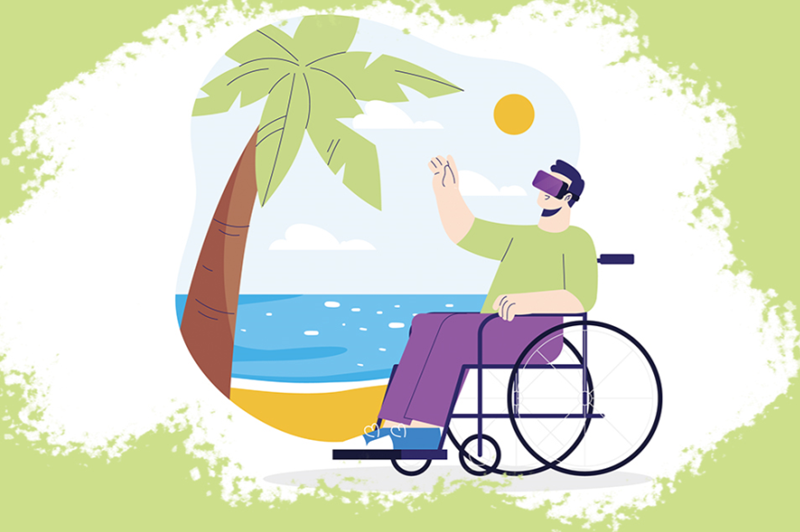Accessibility has always been a major issue for people living with disability. Sadly, the majority of people not living with disability are woefully ignorant of what other people have to deal with on a daily basis.
The same mindset applied in the world of hardware and software R&D – until fairly recently. So, it’s a good idea to take a closer look at the topic.
Accessibility – A Brief History
From the earliest times, people living with disability have been disadvantaged by their environment.
Buildings, equipment, utensils, you name it, pretty much everything in everyday use was designed and produced with little or no thought for people who didn’t have fully functioning limbs, an absence of psychological conditions or the physical strength to navigate their way through their days.

Source: Mobility Help
People living with disability have either needed assistance or have needed to invent their own workarounds just to get things done.
In many cases, the environment and available equipment can be more disabling than a person’s condition. Imagine the frustration of a wheelchair user, stuck at the bottom of a flight of stairs when a simple ramp would have negated the problem. The same can be said for VR development which was initially slow to take a stand on how to make games and apps accessible for people with a disabilities.
The Modern Era
But things are changing. In the 21st Century, most buildings have wheelchair access and the general population is realising that not everybody lives in a fully accessible world.
The explosion of computer technology and the rush to develop apps over the last few years has made life more accessible than it has ever been; but barriers still exist where developers and designers have either not had the scope or lacked awareness to plan for people with disability.
What Happens when Disability Meets Hi-Tech?
Disability in the world of technology happens where a person can’t access a programme or app through the a phone, touch screen or keyboard. It happens when someone can’t see a screen clearly. It happens when people have restricted limb movement and where accessibility tools are provided but even these are beyond the capabilities of the user.
Vision impairment is probably one of the greatest barriers to people using IT equipment. If a person can’t see a screen clearly then clickable links, buttons and keystrokes are of no use. If they have weak hands or impaired coordination, a mouse click or scrolling could be a significant challenge.
Where is VR in All This?
In the VR space, many applications are designed for users with fully functioning limbs and the ability to move, bend and twist their bodies. In some cases, apps presume the user will be within a certain height range so are not accessible to people who are shorter than average.

Source: VIVE
Fortunately, with the rapid development of VR, AR and XR, a lot of attention is being focussed on accessibility and the landscape has already begun changing.
Where it Started and Where it is Now
There were several attempts at creating VR equipment, but cost and the technology of the time meant they were never really commercially viable, so let’s call flight simulators and driving simulators the great granddaddies of today’s VR.

These massive machines were only available to members of select groups – pilots getting to know the next generation fighter jets or passenger aircraft; racing drivers or military personnel training to handle super-fast or abnormally heavy vehicles.
In short, the technology was highly specialised, really expensive and narrowly focussed. Accommodating disability was never on the agenda.
The VR and XR landscape couldn’t be more different. The latest high definition visual equipment, incredible audio systems and haptic systems of all shapes and sizes are worked into products ordinary citizens can buy and take home with them.

Source: Road to VR
You no longer need a warehouse for your PF-22 Raptor simulator or your Lord of the Rings and Harry Potter 3D experiences. Your lounge will do just fine – as long as you’re not a wheelchair user or otherwise prevented from immersing yourself in the wonders of VR and XR.
A Changing Landscape
With VR and tech developments in other areas, the default starting point has shifted. Take Microsoft and Oculus for instance. These companies have made disability a central issue in their technical recommendations for designers and developers. Because of documents like the Microsoft Unity Development platform and the Oculus Accessibility Virtual Reality Checks (VRCs) developers are increasingly focussed on accommodating people with disabilities from the start of their projects – they are no longer an afterthought.

A Great Start, But Still a Way to Go
Will there ever be full accessibility? It’s difficult for developers and manufacturers to respond to all the ways people can be excluded from the full VR experience, but the tools available to ensure inclusion are increasing in number, power and flexibility.
Why is VR Different from Xbox or PlayStation?
XR, VR and related technologies are being driven to be fully inclusive because they are not confined to gaming and home entertainment.
These may be significant markets, but they don’t have the same punch as commercial and industrial interests. When medicine, all levels of manufacturing, education and big corporate-level training get involved, things start to happen.

Source:PROVEN REALITY
Virtual Reality is rapidly making its way into all aspects of corporate life and when Fortune 500 companies pay attention to a specific area, there is bound to be significant development.
AUBIKA– Where Accessibility Has a Home
At AUBIKA we have a mission: to design and develop tools and accessories that will help make VR and XR accessible to everyone, regardless of their physical abilities.
We welcome and encourage input and ideas from all areas of society, so, please let us know thoughts and opinions – we would love to hear from you.

